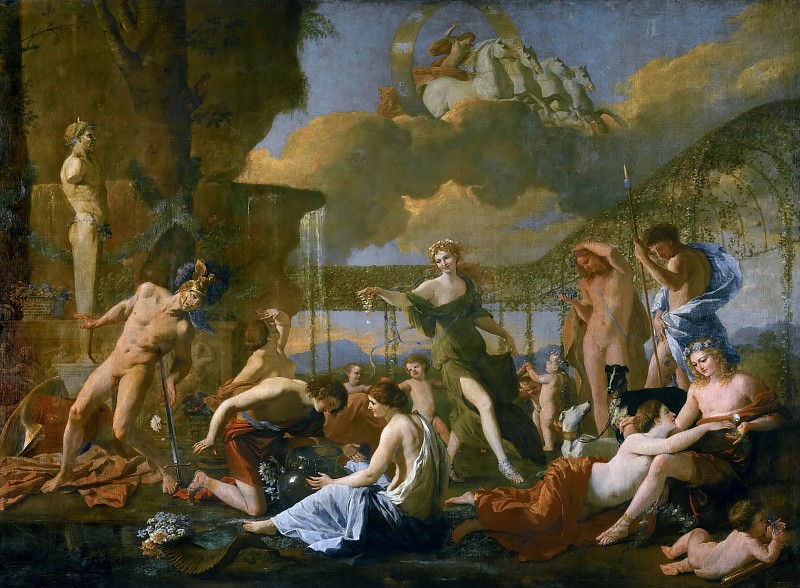The Empire of Flora Nicolas Poussin (1594-1665)
Nicolas Poussin – The Empire of Flora
Edit attribution
Download full size: 4224×3101 px (3,8 Mb)
Painter: Nicolas Poussin
Location: Old Masters Picture Gallery (Gemäldegalerie Alte Meister), Dresden.
One of Nicolas Poussin’s most famous works of art, The Kingdom of Flora is a poeticization of images executed in painting. Over time, the colors in the painting have faded a bit, but originally this masterpiece work of art radiated light. This is confirmed even now, the main thing is to pay attention to the flawless blue color of the sky and the pleasure with which Apollo rushes on his frisky four into the distance. Turning our attention to the central scene of the painting, we can’t leave unnoticed the herma of Priapus, the ancient god who guarded the gardens and brought fertility.
Description of Nicolas Poussin’s painting The Kingdom of Flora
One of Nicolas Poussin’s most famous works of art, The Kingdom of Flora is a poeticization of images executed in painting. Over time, the colors in the painting have faded a bit, but originally this masterpiece work of art radiated light. This is confirmed even now, the main thing is to pay attention to the flawless blue color of the sky and the pleasure with which Apollo rushes on his frisky four into the distance.
Turning our attention to the central scene of the painting, we can’t leave unnoticed the herma of Priapus, the ancient god who guarded the gardens and brought fertility. In front of us is a tree figure, exactly such herms were placed in ancient times. Then we see a tree wrapped in greenery, the emerald jets of a fountain. In the background is a pergola with greenery and flowers twisting around it.
In the center of the picture in front of us, in a graceful dance with a beautiful flower wreath on her head, the goddess of spring flowering Flora. In the foreground, on the right, in front of us are the mythical heroes, Smilaka, who seems to envelop her beloved Crocus with her gentle hands. Behind the couple in love, we see Adonis with his dogs, holding a spear. Adonis is mortally wounded, yet he looks at his wound quite calmly. After his death, at the wish of his beloved Aphrodite, magnificent anemone flowers grow from drops of his blood. To the left of Adonis sits Geocynthus, who was killed by an iron disk at the hand of his friend Apollo. Apollo, being in the mountain turned the drops of his friend’s blood into Geocynthus. The geocynth depicted in the painting is sadly looking at these flowers.
On the left, in the foreground, we see the self-loving Narcissus admiring his reflection and the nymph Echo holding up an amphora. Behind Narcissus we see Clytia, who, according to tradition, was punished by her father for adultery. She sat motionless for a long time, day by day observing the movements of the sun, and then she was absorbed into the earth and transformed into a heliotrope. The image, which is located on the far left, is Ajax, who in a fit of madness sent upon him by Athena, cut up a herd of bulls, the warrior woke up, could not bear the shame and killed himself by thrusting the sword into his body.
It is impossible to lose sight of the circle of Cupids faithfully following their goddess Flora, who showered her guests with beautiful flowers.
Кому понравилось
Пожалуйста, подождите
На эту операцию может потребоваться несколько секунд.
Информация появится в новом окне,
если открытие новых окон не запрещено в настройках вашего браузера.
You need to login
Для работы с коллекциями – пожалуйста, войдите в аккаунт (open in new window).














COMMENTS: 1 Ответы
голые и голые и голые
жара
You cannot comment Why?
The painting The Empire of Flora depicts a vibrant and allegorical scene filled with mythological figures and symbolic elements.
What I see:
At the center of the composition, a radiant woman, presumably Flora, the goddess of flowers, presides over a gathering of nymphs, satyrs, and putti. She is dressed in an emerald green chiton and is adorned with a floral wreath. Her gesture, with an outstretched hand holding grapes, suggests abundance and fertility.
To the left, a muscular male figure in ornate armor, possibly a warrior or a god like Mars, is shown recoiling or falling, with a sword at his feet. This scene is set against a backdrop of classical architecture, including a statue on a pedestal and a cascading waterfall.
Surrounding Flora, various figures are engaged in activities related to nature and revelry. Some are shown tending to flowers, while others embrace or recline. Cherubic putti are scattered throughout, adding a sense of playfulness. Two dogs, one standing attentively and another reclining, are also present.
In the upper part of the painting, a celestial chariot pulled by horses emerges from swirling clouds, possibly representing the sun god Helios or the cyclical nature of time and seasons. The overall setting is an idyllic garden, lush with foliage and vines, creating an atmosphere of beauty and enchantment.
Subtexts:
The Empire of Flora is rich in symbolic meaning, primarily revolving around the themes of: